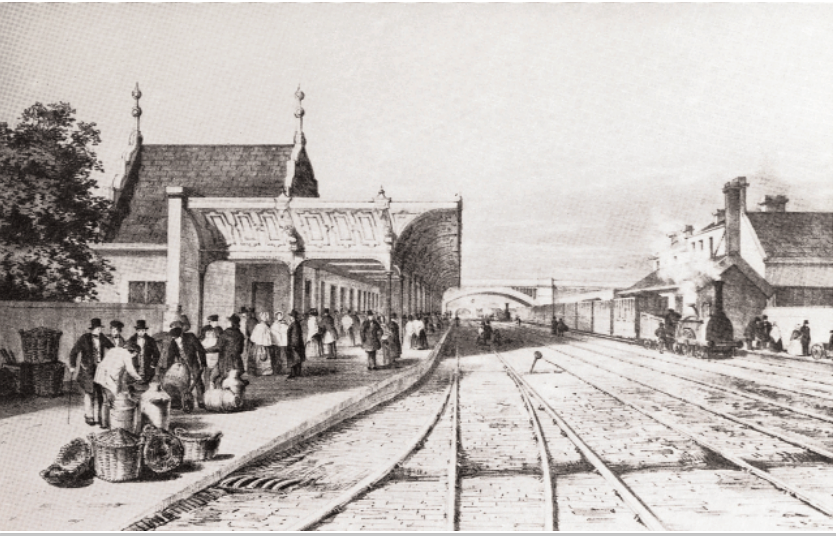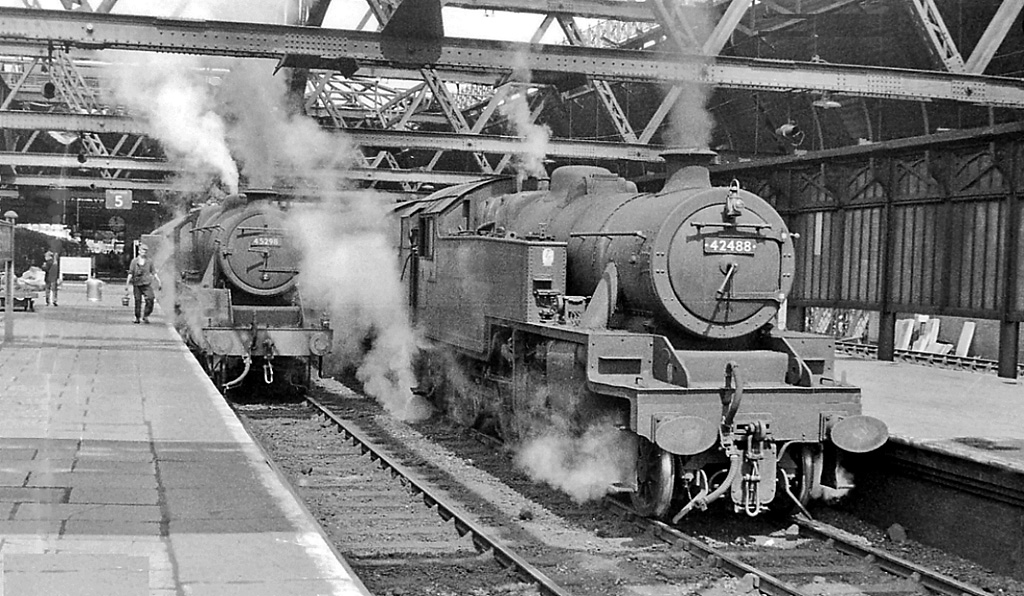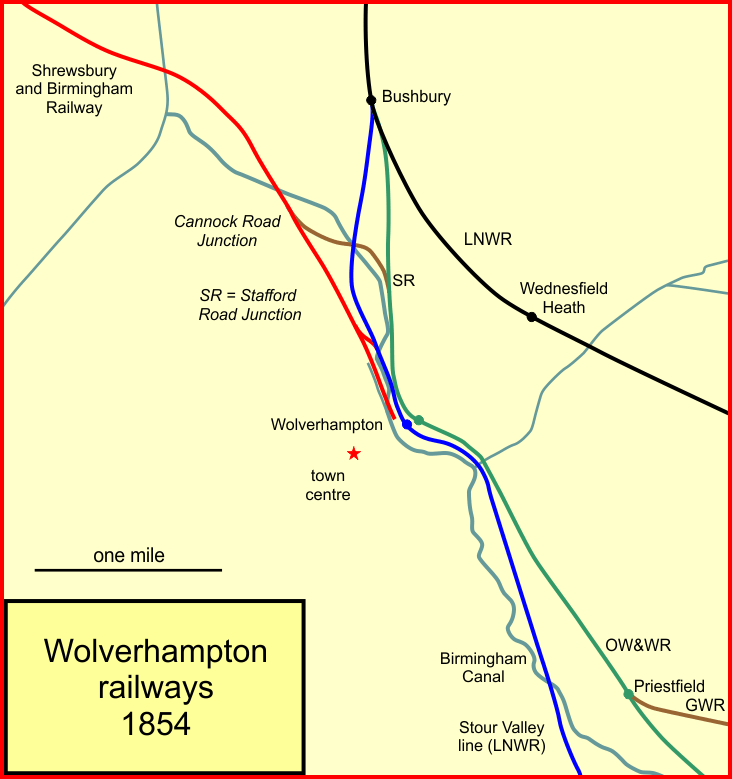|
Dudley Port Railway Station
Dudley Port railway station serves the Dudley Port and Great Bridge areas of Tipton, West Midlands, England, Situated on the Stour Valley Line, the station is operated by West Midlands Railway. Upper Level station History The station opened in 1852. The line had passenger usage until about the early 1880s, when it began to slump at several stations, leading to the line becoming a largely freight only operation in 1887. It would remain open for goods traffic, which was considerable at this time, as the district had become highly industrialised in the then heyday of the Black Country's industrial past. As the local industry declined and road transport became more common, the station entered a post-World War II decline. Despite the name, and being located just north-east of the town centre of Dudley (which has not had its own railway station since 1964), Dudley Port station is not actually situated within the boundaries of the Borough of Dudley, but rather in the adjacent San ... [...More Info...] [...Related Items...] OR: [Wikipedia] [Google] [Baidu] |
Tipton
Tipton is an industrial town in the West Midlands in England with a population of around 38,777 at the 2011 UK Census. It is located northwest of Birmingham. Tipton was once one of the most heavily industrialised towns in the Black Country, with thousands of people employed in the town's industries. Its factories began closing in the 1970s and it has gradually become a commuter town, home largely to people working in other parts of the region. Historically within Staffordshire, the town is now in the borough of Sandwell, It is located adjacent to the towns of Dudley, Wednesbury, Moxley, Darlaston and Bilston. It is also located between Wolverhampton and Birmingham. It also incorporates the areas of Tipton Green, Ocker Hill, Dudley Port, Horseley Heath and Great Bridge. Tipton was an urban district until 1938, when it became a municipal borough. Much of the Borough of Tipton was transferred into West Bromwich County Borough in 1966, but parts of the old borough were a ... [...More Info...] [...Related Items...] OR: [Wikipedia] [Google] [Baidu] |
Birmingham Canal
The BCN Main Line, or Birmingham Canal Navigations Main Line is the evolving route of the Birmingham Canal between Birmingham and Wolverhampton in England. The name ''Main Line'' was used to distinguish the main Birmingham to Wolverhampton route from the many other canals and branches built or acquired by the Birmingham Canal Navigations company. BCN Old Main Line On 24 January 1767 a number of prominent Birmingham businessmen, including Matthew Boulton and others from the Lunar Society, held a public meeting in the White Swan, High Street, Birmingham''Smethwick and the BCN'', Malcolm D. Freeman, 2003, Sandwell MBC and Smethwick Heritage Centre Trust to consider the possibility of building a canal from Birmingham to the Staffordshire and Worcestershire Canal near Wolverhampton, taking in the coalfields of the Black Country. They commissioned the canal engineer James Brindley to propose a route. Brindley came back with a largely level but meandering route via Smethwick, Oldbury ... [...More Info...] [...Related Items...] OR: [Wikipedia] [Google] [Baidu] |
South Staffordshire Railway
The South Staffordshire Railway (SSR) was authorised in 1847 to build a line from Dudley in the West Midlands of England through Walsall and Lichfield to a junction with the Midland Railway on the way to Burton upon Trent, with authorised share capital of £945,000. It was supported by the newly-formed London and North Western Railway (LNWR) and the Midland Railway, giving each company access to important areas. It completed its main line in 1849. As collieries in the Cannock region rose in importance, it built a second main line from Walsall to Rugeley, as well as numerous short spurs and connections to lines it intersected. Colliery working in the Cannock area expanded enormously, and mineral traffic carryings increased in step. In 1850 the entire company's operation was leased to a private individual, John Robinson McClean, the first time this was ever done. His lease was successful, but the London and North Western Railway wanted control of the network for its own strategic pu ... [...More Info...] [...Related Items...] OR: [Wikipedia] [Google] [Baidu] |
Crewe Railway Station
Crewe railway station is a railway station in Crewe, Cheshire, England. It opened in 1837 and is one of the most historically significant railway stations in the world.Guardian newspaper article, ''The beauty of Crewe'' (6 December 2005). Retrieval Date: 10 August 2007. Crewe station is a major junction on the and serves as a rail gateway for . It is 158 miles north of |
Shrewsbury Railway Station
Shrewsbury railway station is in Shrewsbury, Shropshire, England. Built in 1848, it was designated a grade II listed building in 1969. The station is north west of Birmingham New Street. Many services starting at or passing through the station are bound for Wales; it is operated by Transport for Wales, although the station is also served by Avanti West Coast and West Midlands Railway services, and is one of the key network hubs of Transport for Wales. History The station was formerly known as Shrewsbury General and is the only remaining railway station in the town; Shrewsbury Abbey, as well as other small stations around the town, having long closed. Shrewsbury railway station was originally built in October 1848 for the county's first railway — the Shrewsbury to Chester Line. The architect was Thomas Mainwaring Penson of Oswestry. The building is unusual, in that the station was extended between 1899 and 1903 by the construction of a new floor underneath the original st ... [...More Info...] [...Related Items...] OR: [Wikipedia] [Google] [Baidu] |
Birmingham New Street Railway Station
Birmingham New Street is the largest and busiest of the three main railway stations in Birmingham city centre, England, and a central hub of the British railway system. It is a major destination for Avanti West Coast services from , and via the West Coast Main Line, the CrossCountry network, and for local and suburban services within the West Midlands; this includes those on the Cross-City Line between , and , and the Chase Line to and . The three-letter station code is BHM. The station is named after New Street, which runs parallel to the station, although the station has never had a direct entrance except via the Grand Central shopping centre. Historically, the main entrance to the station was on Stephenson Street, just off New Street. As of 2022, the station has entrances on Stephenson Street, Smallbrook Queensway, Hill Street and Navigation Street. New Street is the fifth busiest railway station in the UK and the busiest outside London, with 46.5 million passenger ... [...More Info...] [...Related Items...] OR: [Wikipedia] [Google] [Baidu] |
Stafford Railway Station
Stafford railway station is a major interchange railway station in Stafford, Staffordshire, England, and is the second busiest railway station in Staffordshire, after Stoke-on-Trent. The station serves the county town, as well as surrounding villages. The station lies on the junction of the Trent Valley Line, the Birmingham Loop/ Rugby-Birmingham-Stafford Line, and the West Coast Main Line. Stafford station also formerly served the now defunct Stafford to Uttoxeter and Stafford to Shrewsbury lines. The current brutalist station building was built in 1962, and is the fourth station to have existed on this site. The interior of the station was refurbished in 2015, which allowed the station to have a new WHSmith store and an improved ticket office. History The first station was built by the Grand Junction Railway and opened in July 1837. It soon became inadequate and was replaced by a second station in 1844. A third station was built in 1862, which was eventually replaced b ... [...More Info...] [...Related Items...] OR: [Wikipedia] [Google] [Baidu] |
Wolverhampton Railway Station
Wolverhampton railway station in Wolverhampton, West Midlands, England is on the Birmingham Loop of the West Coast Main Line. It is served by Avanti West Coast, CrossCountry, Transport for Wales and West Midlands Trains services, and was historically known as Wolverhampton High Level. History The first station named ''Wolverhampton'' had opened on the edge of the town centre in 1837 on the Grand Junction Railway, this station was renamed Wednesfield Heath in 1855, shortly after the present station was opened, and then was closed in 1873. On 12 November 1849, the Shrewsbury and Birmingham Railway opened a temporary terminus to its line, at a location very close to the present station. The present station was opened on 1 July 1852 by the Birmingham, Wolverhampton and Stour Valley Railway, a subsidiary of the London and North Western Railway (LNWR); it was named ''Wolverhampton Queen Street''. The only visible remnant of the original station is the Queen's Building, the ga ... [...More Info...] [...Related Items...] OR: [Wikipedia] [Google] [Baidu] |
Walsall Railway Station
Walsall railway station is the principal railway station of Walsall, West Midlands, England and situated in the heart of the town. It is operated by West Midlands Trains, with services provided by West Midlands Railway and from 2019, London Northwestern Railway operate a service from Rugeley to London Euston that calls at the station. The main entrance is situated inside the Saddlers Shopping Centre. Overview Services from the station go to Birmingham New Street south on the Walsall Line, (operated on behalf of Transport for West Midlands), and north to Cannock and Rugeley. The station has three platforms: *Platform 1: operating northbound services to Rugeley; *Platform 2: operating southbound, semi-fast services from Rugeley to Birmingham New Street; *Platform 3: (a terminus platform) operating local services to Wolverhampton via Birmingham New Street. Platforms 2 and 3 have been recently refurbished, with a new waiting room added and poems on the walls of the stairs to ... [...More Info...] [...Related Items...] OR: [Wikipedia] [Google] [Baidu] |
Dudley Port Station Plaque
Dudley is a large market town and administrative centre in the county of West Midlands, England, southeast of Wolverhampton and northwest of Birmingham. Historically an exclave of Worcestershire, the town is the administrative centre of the Metropolitan Borough of Dudley; in 2011 it had a population of 79,379. The Metropolitan Borough, which includes the towns of Stourbridge and Halesowen, had a population of 312,900. In 2014 the borough council named Dudley as the capital of the Black Country. Originally a market town, Dudley was one of the birthplaces of the Industrial Revolution and grew into an industrial centre in the 19th century with its iron, coal, and limestone industries before their decline and the relocation of its commercial centre to the nearby Merry Hill Shopping Centre in the 1980s. Tourist attractions include Dudley Zoo and Castle, the 12th century priory ruins, and the Black Country Living Museum. History Early history Dudley has a history dating ba ... [...More Info...] [...Related Items...] OR: [Wikipedia] [Google] [Baidu] |
West Midlands County Council
West Midlands County Council (WMCC) was, from 1974 to 1986, the upper-tier administrative body for the West Midlands county, a metropolitan county in England. History The WMCC existed for a total of twelve years. It was established on 1 April 1974, by the Local Government Act 1972 and was abolished on 31 March 1986. It was abolished along with five other metropolitan county councils and the Greater London Council by the government of Margaret Thatcher under the Local Government Act 1985. The WMCC was a strategic authority running regional services such as transport, emergency services, and strategic planning. Elections were held to the council in 1973, 1977 and 1981. Elections were due to be held in 1985 but were cancelled due to the council's impending abolition. The Labour Party controlled the council from 1974 to 1977, with the Conservatives controlling it 1977–81. It reverted to Labour control for the last term 1981–86. Premises The first meeting of the shadow authorit ... [...More Info...] [...Related Items...] OR: [Wikipedia] [Google] [Baidu] |






.jpg)



.jpg)